[.[.《新编实用英语综合教程》说课稿(1)
- 格式:pdf
- 大小:1022.90 KB
- 文档页数:6
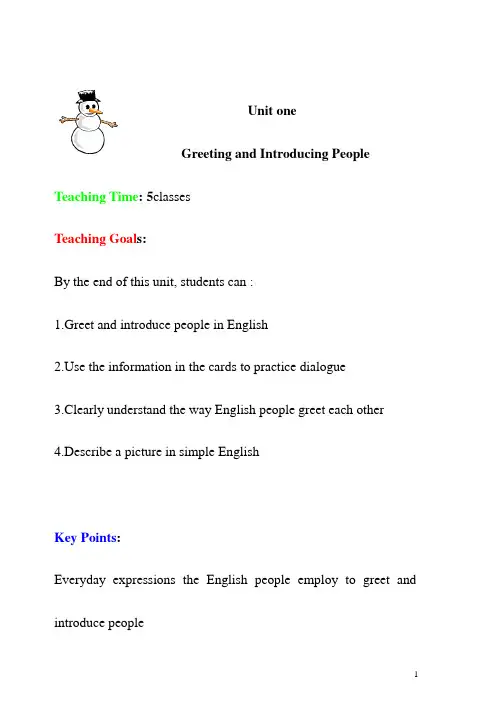
Unit oneGreeting and Introducing People Teaching Time: 5classesTeaching Goal s:By the end of this unit, students can :1.Greet and introduce people in Englishe the information in the cards to practice dialogue3.Clearly understand the way English people greet each other4.Describe a picture in simple EnglishKey Points:Everyday expressions the English people employ to greet and introduce people1st class: 50ms. Talking Face to FaceStep 1 . PresentationⅠ. Introducing myself according to my calling card: Good morning / afternoon, boys and girls! Nice to meet.Welcome to our college! My name is Yao fangfang . My English name is Yvonne. You can call me Mrs Yao or Yvonne as you like. From now on, we will be together through this term. I hope we can get well on with each other. I believe so! At last, I would like to give you my heartfelt wishes for you. May you have good study and campus life here.Ⅱ.Show them my calling card and explanation:first name/given name; (given at baptism)名last name/ family name:姓eg: Eliot T. SamuelⅢ.Give some useful expressions of greeting:A: Meeting people for the first timeHi / hello, nice to meet you. ( nice/glad/ honoured )Or:How do you do?How do you do?B: Meeting people againLong time no see/ how are you/ how have you been?It’s been quite a while, hasn’t it?How are you? Fine / nice/ pretty good/ not so bad/ just so so/ very well.That’s all right.How is your work / family?Ⅳ. Let students introduce themselves to me!Use the expression above.Step 2. Learn the samplesDialogue 1/ Dialogue 2.Ask students read them aloud and then practice them in pairs.Give some advice on how to learn English well.Four basic skills: Read, listening speaking and writing.Step 3. Act out ( homework)Look through and give the task to the students.Practice them in next class.Step 4 ..Homework: read aloud and learn by heart the “data bank”2nd class: Being All EarsKey language points1.leave a good impression upon sb.Your proper greeting leaves a good first impression upon me.2. rather3.each +V single4.that cool but inexperienced man5.I’ve got to6.speak of : mention7. nice to have met you.Step 1: Review check the homework. Act outStep 2. Listen to the dialogue and decode (twice)Step 3. Listen and respondListen to the dialogue again and answer the following questionsStep 4.Listen and completeNow listen to dialogue and complete the following sentences. Step 5. Listen and judge.Step 6.Read—listen—match and concludeMaterial: Introduction are important. P7Section Ⅲ( 3rd and 4th .5 classes) Maintaining a sharp eye Mr.: a courtesy title for any male adult not for styled sir”, “Dr”etc, used before the man’s family name or his position.b.Mrs.:“太太”a courtesy title for any married woman not styled“Lady”,“Dr.”etc.used before her husband’s .surname c.Ms.:“女士”a courtesy bile for a woman,whether she is married or not,followed by the family name.Miss:“小姐”A title to address an unmarried woman or a girl.It is followed by the family name.Miss can also be used as he title of address to an (esp.unknown)unmarrined woman. In this case,it is not followed by the name.l. Explanation of Difficult Sentences.1.(Title)The Way Americans GreetAnalysis:In this title,in which is omitted after the way> in…way means( to do sth ) by means of means a certain method美国人致意的方式Example:I think the way she runs her bookshop is worth studying.2. Speaking of time. I’ve got to run.A present participle clause used as an adverbial of cause/time. It means “ when it comes to time, I am reminded of…”说到时间,我得赶紧跑了。
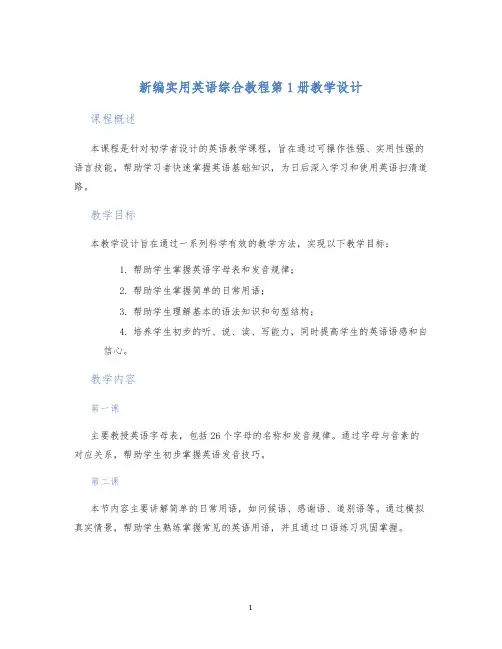
新编实用英语综合教程第1册教学设计课程概述本课程是针对初学者设计的英语教学课程,旨在通过可操作性强、实用性强的语言技能,帮助学习者快速掌握英语基础知识,为日后深入学习和使用英语扫清道路。
教学目标本教学设计旨在通过一系列科学有效的教学方法,实现以下教学目标:1.帮助学生掌握英语字母表和发音规律;2.帮助学生掌握简单的日常用语;3.帮助学生理解基本的语法知识和句型结构;4.培养学生初步的听、说、读、写能力,同时提高学生的英语语感和自信心。
教学内容第一课主要教授英语字母表,包括26个字母的名称和发音规律。
通过字母与音素的对应关系,帮助学生初步掌握英语发音技巧。
第二课本节内容主要讲解简单的日常用语,如问候语、感谢语、道别语等。
通过模拟真实情景,帮助学生熟练掌握常见的英语用语,并且通过口语练习巩固掌握。
第三课本节内容主要引导学生学习并掌握英语语法方面的基础知识,如主语、谓语、定语、状语等基本概念,并且通过练习巩固掌握。
第四课本节内容主要介绍英语代词、形容词、副词的基础知识,帮助学生掌握词汇量的同时,提高学生对英语语法的敏感性,同时辅以口语练习提高听说能力。
第五课本节内容主要让学生了解问题句型及回答方式,并帮助学生掌握各种相应句子类型的语法。
第六课综合性课程内容,巩固学生对前几节课的掌握,同时给予口语表达、语音、语法等方面的全面训练。
教学方法本教学设计将采用两大类方法,一类为传统教学方式,一类为现代教学方式。
传统教学方式1.讲授法:将基础知识讲授给学生,辅以学生手册和黑板板书,帮助学生初步掌握英语基础知识;2.练习法:通过不同形式的习题练习,巩固学生的掌握程度,并且帮助学生在做题过程中发现自己的不足,及时进行纠正。
现代教学方式1.互动式教学: 以学生为主体,让学生在讲师引导和促进下进行互动学习;2.多媒体教学: 利用现代多媒体教学手段,如PPT、录像等多媒体技术,结合学生实际情况和教学目标,对课程内容进行更直观、生动的展现。
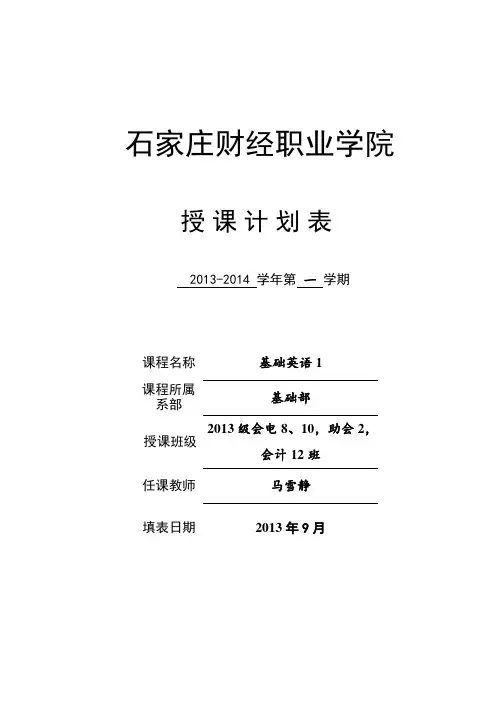
石家庄财经职业学院授课计划表2013-2014 学年第一学期课程名称基础英语1课程所属系部基础部授课班级2013级会电8、10,助会2,会计12班任课教师马雪静填表日期2013年9月石家庄财经职业学院基础部系部 2013 — 2014学年第一学期授课计划表教师姓名:马雪静课程名称:基础英语1 专业:13级会电会电8、10,助会2,会计12班教案头Free TalkFirst, greet students and do a short self-introduction and tell my phone number and the location of my office to students to contact me conveniently.Second, ask the students to introduce themselves in English one by one, which aims to prompt students to speak as much English as possible. And the following questions can be covered when the teacher prompts students to speak more in English.1. What’s your name? Where are you from?2. What’s your major?I major in/My major is accounting.3. Why did you choose this college?4. What’s your deepest impression upon our college and our teachers in the college?5. What’s your hobby? What do you usually do after class?6. What’s your favorite color, book, course and etc and ask them why.7. How do you pay for your tuition fees? By your parents or yourself?8. Do you think English is very difficult to learn well? If so, what do you think is the most difficult when learning English?Third, ask the students some questions about their summer holiday to get acquainted with the students.1. What have you done during the summer holiday?2. Have you ever read any book or seen any intriguing film? And can you tell us the main idea of the book or the film?3. Have you had a part-time job in your holiday? And do you want to share your working experience with us, if you did very well?This helps them to develop their communication skills and helps them get comfortable with speaking and interacting with all the students in the class.Forth, introduce the aims and teaching procedures of the course for the students. And illustrate the makeup of the final grade and emphasize the discipline in the class and speech for each class.Finally, tell students how to learn English well:Speak without FearThe biggest problem most people face in learning a new language is their own fear. They worry that they won’t say things correctly or that they will look stupid so they don’t talk at all. Don’t do this. The fastest way to learn anything is to do it – again and again until you get it right. Like anything, learning English re quires practice. Don’t let a little fear stop you from getting what you want.Use all of your ResourcesEven if you study English at a language school it doesn’t mean you can’t learn outside of class. Using as many different sources, methods and tools as possible, will allow you to learn faster. There are many different ways you can improve your English, so don’t limit yourself to only one or two. The internet is a fantastic resource for virtually anything, but for the language learner it's perfect.Surround Yourself with EnglishThe absolute best way to learn English is to surround yourself with it. Take notes in English, put English books around your room, listen to English language radio broadcasts, watch English news, movies and television. Speak English with your friends whenever you can. The more English material that you have around you, the faster you will learn and the more likely it is that you will begin “thinking in English.”Listen to Native Speakers as Much as PossibleThere are some good English teachers that have had to learn English as a second language before they could teach it. However, there are several reasons why many of the best schools prefer to hire native English speakers. One of the reasons is that native speakers have a natural flow to their speech that students of English should try to imitate. Thecloser ESL / EFL students can get to this rhythm or flow, the more convincing and comfortable they will become. Watch English Films and TelevisionThis is not only a fun way to learn but it is also very effective. By watching English films (especially those with English subtitles) you can expand your vocabulary and hear the flow of speech from the actors. If you listen to the news you can also hear different accents.Listen to English MusicMusic can be a very effective method of learning English. In fact, it is often used as a way of improving comprehension. The best way to learn English is to get the lyrics (words) to the songs you are listening to and try to read them as the artist sings. There are several good internet sites where one can find the words for most songs. This way you can practice your listening and reading at the same time. And if you like to sing, fine.Study As Often As Possible!Only by studying things like grammar and vocabulary and doing exercises, can you really improve your knowledge of any language.Do Exercises and Take TestsMany people think that exercises and tests aren't much fun. However, by completing exercises and taking tests you can really improve your English. One of the best reasons for doing lots of exercises and tests is that they give you a benchmark to compare your future results with. Often, it is by comparing your score on a test you took yesterday with one you took a month or six months ago that you realize just how much you have learned. If you never test yourself, you will never know how much you are progressing. Start now by doing some of the many exercises and tests on this site, and return in a few days to see what you've learned. Keep doing this and you really will make some progress with English.Record YourselfNobody likes to hear their own voice on tape but like tests, it is good to compare your tapes from time to time. You may be so impressed with the progress you are making that you may not mind the sound of your voice as much.教案头Unit 1 Hello, Hi!SectionⅠTalking Face to FaceI.Imitating Mini-talks1. pair worka. The students are asked to read the first three talks in pairs and speak out the sentences used when people meet for the first time.b. The students are then asked to read the last two talks in pairs and speak out the sentences used when people meet again.2. The teacher may give more expressions for the students to practice.II. Acting out tasksPair work. The students make short conversations by following the above mini-talks.III. Studying Business Cards1.The students read the business cards and answer some questions.Questions for the two cardsa.Wh at’s the name of the man?b.Where does he work?c.What is his job?d.Where is his working place?2.The students read the letter again and then translate it orally under the guidance of the teacher.IV Following sample dialoguesThe students read the dialogues and speak out the following sentences of greeting and introducing people. Then the students will be asked to practice them.1.Hello, nice to meet you . My name is .......2. How do you do, ... I’m ....3. Welcome to ...4. Here is my card.5. Hi, long time no see6. How nice to see you again7. Haven’t seen you for ages8. What a pleasant surprise!V Putting language to useThe students do the exercises 5 and 6 according to the knowledge they have mastered in the dialogues.教案头Unit 1 Hello, Hi!Section ⅡBeing All EarsI Learning sentences for workplace communicationThis part is to train the students to understand and speak out the sentences.1.The students listen to ten English sentences given in the course book and repeat them in the pauseallowed, trying to understand and learn to speak them out by referring to their Chinese meanings.2.The students listen to ten sentences , and match them with their Chinese translations.3.The students listen to six sentences giving in the course book, and then choose their right responses.1.II Handing a dialogue s.This part is moving from the sentence to the dialogue level.The students listen twice to a dialogue, and then decode the message given in the course book by finding the correct choiceIII. Understanding a short speechThis part of training is carried out to help the students to follow the continuous oral presentation of a specific practical activity which is oriented to the unit topic.1. The students listen to the speech twice and during the second listening, put back the missing words in the blanks.2. The students listen to the speech again and match the information in Column A with the choices in Column B.教案头Unit 1 Hello, Hi!Section III Trying Your HandI Practicing applied writing1. Sample analysisThe teacher makes the following brief analysis of the format and language used in business cards. The teacher may take Sample 1 as an example for the analysis and asks the students some questions:a.Wh at’s the name of the man?b.Where does he work?c.What is his job?d.Where is his working place?2.personal information must be included in a business cardfull name job working place unit address telephone number E-mail FaxII Writing sentences and reviewing grammarThe teacher introduce basic sentence structures with the following examples.1. 主语+谓语(+宾语)(+状语)Animals can’t speak (主+谓)Mary runs every morning (主+谓+状)They speak English (主+谓+宾)I gave him a visiting card.(主+谓+间宾+直宾)She loves dogs very much. (主+谓+宾+状)2.主系表He is a man3.There be 句型There is a dog in the room教案头Unit 1 Hello, Hi!Section ⅣPassage I The Business Cards:I. Warming-up questionsi. What do you think of a business card?ii. What tips should you know about the business card?II. Ask the students to skim the passage and answer the questions on Page 16.1. Have you got your business cards or networking cards? If not, why not?2. How do you understand the title of the passage The Business Card: a Social Faux Pas?A business card is a useful tool of social networking and business connection. It is socially awkward if you find yourself without one when you need to exchange it with a new business partner.3.Why does the author say “missed connections are missed opportunities for business”? Because business cards are a useful marketing tool. If you forget to bring them with you, it May leave the impression that you are unprepared for doing business.4. Can you explain the tips in your own words?1) If you don't have a job, prepare your cards for networking.2) If your business cards are out of date, make them up to date.3) You should set a goal of handing out a certain number of cards every day.4) Practice what you will say for handing out your cards. Take every opportunity to hand out your cards.5) Ask your social network to help you send out your cards.5. What does the last sentence mean?You should work in a clever way: better work isn't necessarily harder!III. Ask students to read the new words and expressions and check their pronunciation. IV. Play the tape for the students and ask them to imitate.V. Analyze the passage and explain the language and difficult sentences.Para11. ask for sth: want sthMay I ask for a photo of your little daughter? 我能要一张你小女儿的照片吗?ask for sbHe is very ill and keeps asking for his daughter. 他病得很厉害, 再三要求见他的女儿。
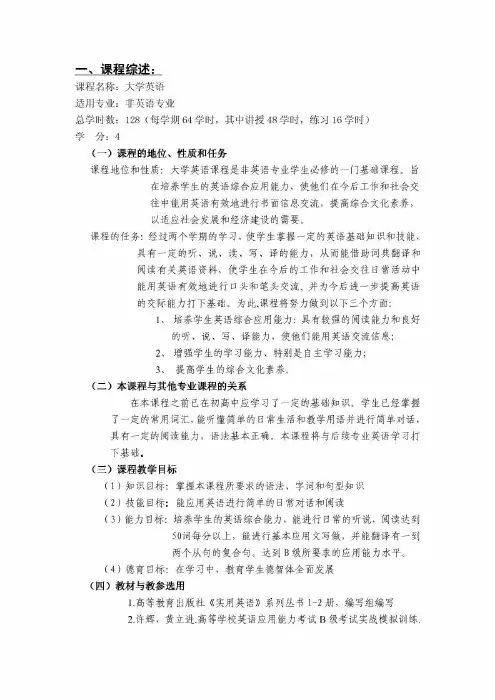
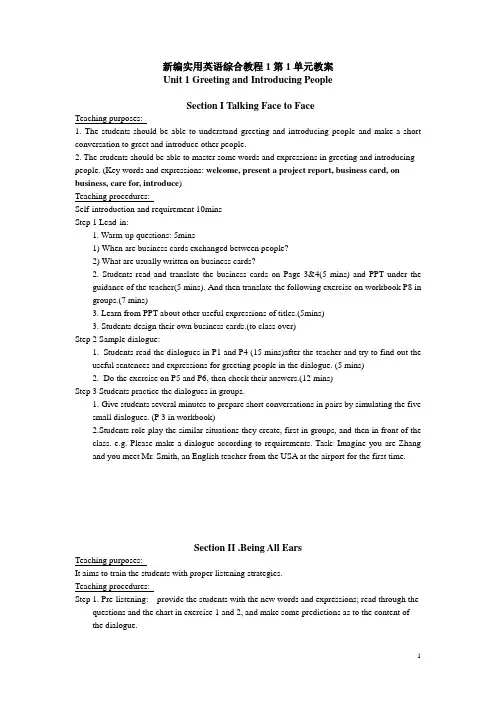
新编实用英语综合教程1第1单元教案Unit 1 Greeting and Introducing PeopleSection I Talking Face to FaceTeaching purposes:1. The students should be able to understand greeting and introducing people and make a short conversation to greet and introduce other people.2. The students should be able to master some words and expressions in greeting and introducing people. (Key words and expressions: welcome, present a project report, business card, on business, care for, introduce)Teaching procedures:Self-introduction and requirement 10minsStep 1 Lead-in:1. Warm-up questions: 5mins1) When are business cards exchanged between people?2) What are usually written on business cards?2. Students read and translate the business cards on Page 3&4(5 mins) and PPT under theguidance of the teacher(5 mins). And then translate the following exercise on workbook P8 in groups.(7 mins)3. Learn from PPT about other useful expressions of titles.(5mins)3. Students design their own business cards.(to class over)Step 2 Sample dialogue:1. Students read the dialogues in P1 and P4 (15 mins)after the teacher and try to find out theuseful sentences and expressions for greeting people in the dialogue. (5 mins)2. Do the exercise on P5 and P6, then check their answers.(12 mins)Step 3 Students practice the dialogues in groups.1.Give students several minutes to prepare short conversations in pairs by simulating the fivesmall dialogues. (P 3 in workbook)2.Students role-play the similar situations they create, first in groups, and then in front of theclass. e.g. Please make a dialogue according to requirements. Task: Imagine you are Zhang and you meet Mr. Smith, an English teacher from the USA at the airport for the first time.Section II .Being All EarsTeaching purposes:It aims to train the students with proper listening strategies.Teaching procedures:Step 1. Pre-listening: provide the students with the new words and expressions; read through the questions and the chart in exercise 1 and 2, and make some predictions as to the content of the dialogue.(Key words and expressions:1.Canada/The United States (of America) / the United Kingdom (of Great Britain andNorthern Ireland); England--Scotland--Welsh--Northern Ireland ;Britain;2.College3.Surprise surprise partyHis visit gave me a pleasant surprise. 他的来访使我感到惊喜。
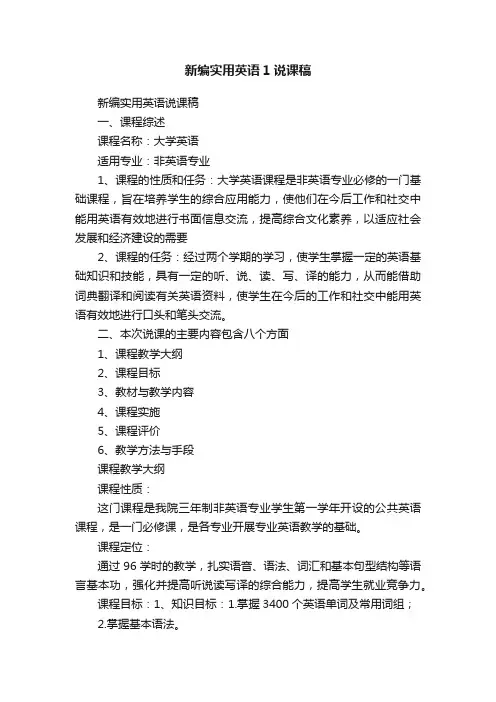
新编实用英语1说课稿新编实用英语说课稿一、课程综述课程名称:大学英语适用专业:非英语专业1、课程的性质和任务:大学英语课程是非英语专业必修的一门基础课程,旨在培养学生的综合应用能力,使他们在今后工作和社交中能用英语有效地进行书面信息交流,提高综合文化素养,以适应社会发展和经济建设的需要2、课程的任务:经过两个学期的学习,使学生掌握一定的英语基础知识和技能,具有一定的听、说、读、写、译的能力,从而能借助词典翻译和阅读有关英语资料,使学生在今后的工作和社交中能用英语有效地进行口头和笔头交流。
二、本次说课的主要内容包含八个方面1、课程教学大纲2、课程目标3、教材与教学内容4、课程实施5、课程评价6、教学方法与手段课程教学大纲课程性质:这门课程是我院三年制非英语专业学生第一学年开设的公共英语课程,是一门必修课,是各专业开展专业英语教学的基础。
课程定位:通过96学时的教学,扎实语音、语法、词汇和基本句型结构等语言基本功,强化并提高听说读写译的综合能力,提高学生就业竞争力。
课程目标:1、知识目标:1.掌握3400个英语单词及常用词组;2.掌握基本语法。
3.掌握听力、口语交流的基本技巧以及应用文写作的格式和常用句型技能目标:培养阅读能力和一定听说读写译的能力学生能够用英语交流信息情感目标:掌握语言学习方法,培养自主学习能力、提升自身素质,加深内涵课程特色:1.素质教育和人文教育2.听说读写译综合能力培养3.课堂学习和自主学习相结合4.教学方法多样,趣味教学5.培养创新思维和批判性思维教材与教学内容:《新编实用英语·第四版》系列教材是普通高等教育“十二五”国家级规划教材,遵循高职高专培养高等应用型人才的目标,通过96学时的学习,使学生掌握必需的、实用的英语语言知识和技能,使学生具有较强的阅读能力,一定的听、译能力和初步的写、说能力以及翻译与其本专业有关的英文资料的初步能力。
教学内容:本课的教学内容为第六单元第四部分阅读训练,我们将围绕奥运和体育展开,以2008北京奥运徽章中国印舞动的北京为主线,多角度多元化地展现了这一场全民族的盛事。
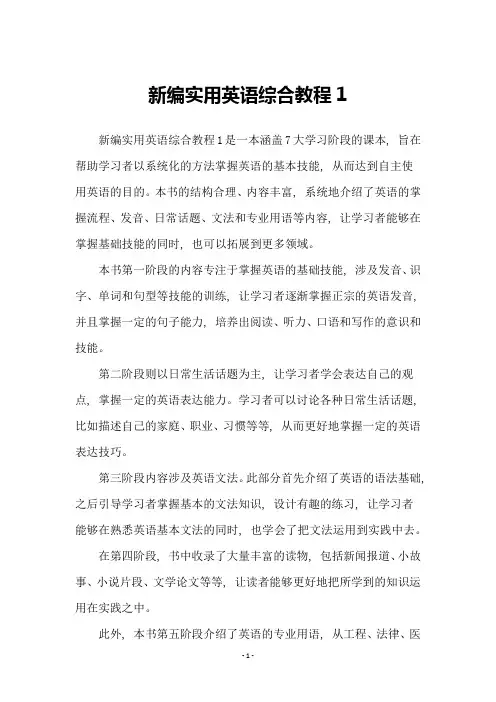
新编实用英语综合教程1新编实用英语综合教程1是一本涵盖7大学习阶段的课本, 旨在帮助学习者以系统化的方法掌握英语的基本技能, 从而达到自主使用英语的目的。
本书的结构合理、内容丰富, 系统地介绍了英语的掌握流程、发音、日常话题、文法和专业用语等内容, 让学习者能够在掌握基础技能的同时, 也可以拓展到更多领域。
本书第一阶段的内容专注于掌握英语的基础技能, 涉及发音、识字、单词和句型等技能的训练, 让学习者逐渐掌握正宗的英语发音, 并且掌握一定的句子能力, 培养出阅读、听力、口语和写作的意识和技能。
第二阶段则以日常生活话题为主, 让学习者学会表达自己的观点, 掌握一定的英语表达能力。
学习者可以讨论各种日常生活话题, 比如描述自己的家庭、职业、习惯等等, 从而更好地掌握一定的英语表达技巧。
第三阶段内容涉及英语文法。
此部分首先介绍了英语的语法基础, 之后引导学习者掌握基本的文法知识, 设计有趣的练习, 让学习者能够在熟悉英语基本文法的同时, 也学会了把文法运用到实践中去。
在第四阶段, 书中收录了大量丰富的读物, 包括新闻报道、小故事、小说片段、文学论文等等, 让读者能够更好地把所学到的知识运用在实践之中。
此外, 本书第五阶段介绍了英语的专业用语, 从工程、法律、医学等多种不同领域为学习者科普常用专业术语, 让掌握英语的技能更加全面。
本书的最后一阶段则以英语写作为主题, 主要介绍英语文章、报告、邮件等的书写方法, 以及文章的结构。
这部分内容有利于帮助学习者掌握英语撰写文章的能力, 丰富学习技能, 拓展在其他领域的技能。
总之, 新编实用英语综合教程1全面、仔细地讲解了英语的学习, 并且从7个不同的方面进行了讲解, 让学习者可以在掌握基础知识的同时, 也可以拓展到更多的领域, 提高英语能力, 进行更有效的英语学习。
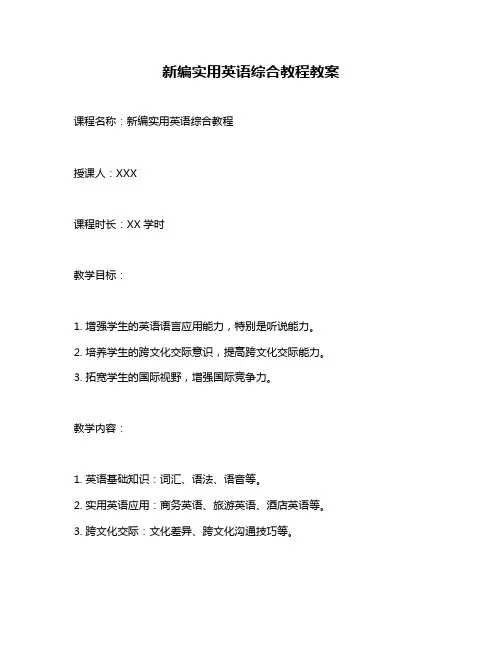
新编实用英语综合教程教案课程名称:新编实用英语综合教程授课人:XXX课程时长:XX学时教学目标:1. 增强学生的英语语言应用能力,特别是听说能力。
2. 培养学生的跨文化交际意识,提高跨文化交际能力。
3. 拓宽学生的国际视野,增强国际竞争力。
教学内容:1. 英语基础知识:词汇、语法、语音等。
2. 实用英语应用:商务英语、旅游英语、酒店英语等。
3. 跨文化交际:文化差异、跨文化沟通技巧等。
教学难点与重点:难点:如何将英语基础知识与实际应用有效结合,提高学生的英语应用能力。
重点:跨文化交际能力的培养,以及如何增强学生的国际竞争力。
教具和多媒体资源:1. 投影仪、电脑、音响等多媒体设备。
2. 英语教材、练习册、听力材料等。
3. 跨文化交际案例、图片、视频等教学资源。
教学方法:1. 讲授法:讲授英语基础知识,如词汇、语法、语音等。
2. 案例分析法:通过分析实际案例,让学生了解跨文化交际的实际情况。
3. 小组讨论法:组织学生进行小组讨论,提高口语表达和交流能力。
4. 角色扮演法:通过角色扮演,模拟实际场景,提高学生的英语应用能力。
教学过程:1. 导入(5分钟):通过提问导入,检查学生预习情况,引起学生的兴趣。
2. 讲授新课(45分钟):讲解英语基础知识和实用英语应用,结合案例分析,引导学生思考。
3. 巩固练习(20分钟):组织学生进行小组讨论、角色扮演等活动,巩固所学内容。
4. 归纳小结(10分钟):总结本节课的重点内容,对学生的表现进行评价,给出建议和指导。
评价与反馈:1. 设计评价策略:通过课堂表现、小组讨论、角色扮演等活动,以及课后作业和测试等形式进行评价。
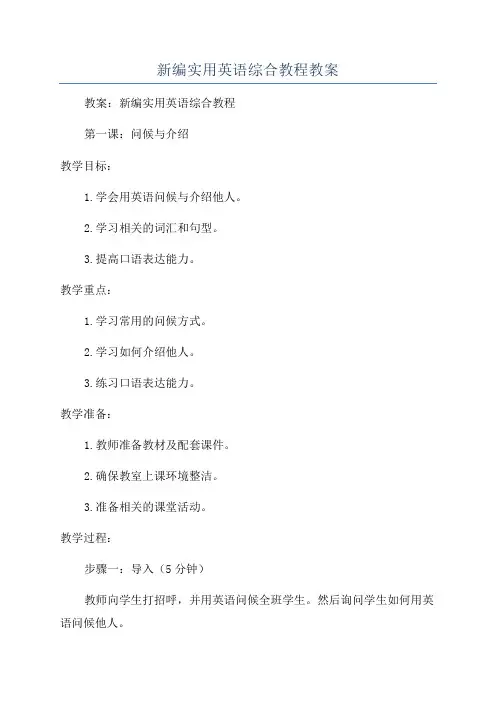
新编实用英语综合教程教案教案:新编实用英语综合教程第一课:问候与介绍教学目标:1.学会用英语问候与介绍他人。
2.学习相关的词汇和句型。
3.提高口语表达能力。
教学重点:1.学习常用的问候方式。
2.学习如何介绍他人。
3.练习口语表达能力。
教学准备:1.教师准备教材及配套课件。
2.确保教室上课环境整洁。
3.准备相关的课堂活动。
教学过程:步骤一:导入(5分钟)教师向学生打招呼,并用英语问候全班学生。
然后询问学生如何用英语问候他人。
步骤二:新知呈现(10分钟)教师提供一些常用的问候方式,并解释其用法和含义。
例如:“How are you?”、“What’s up?”、“How’s it going?”等。
然后教师通过演示的方式向学生展示如何用这些问候方式与他人进行交流。
步骤三:对话练习(10分钟)教师分发练习卡片,学生们分成小组进行对话练习。
每组学生轮流扮演不同的角色,进行问候和介绍的对话练习。
教师可以在课堂辅助学生,纠正他们的发音和语法错误。
步骤四:分组活动(15分钟)教师将学生分成小组,每个小组的成员都有一个袋子,里面放有一些物品。
小组成员通过轮流拿东西,然后用自己的话介绍拿到的物品。
其他组员可以提问或者给出评论。
教师可以在活动过程中引导学生使用相关的句型和表达方式。
步骤五:练习评价(10分钟)教师提供一些练习题,要求学生用英语回答。
例如:“How do you usually greet your friends?”、“How would you introduce yourself in English?”等。
学生们可以在书写或者口头表达上回答问题。
步骤六:小结复习(5分钟)教师对本节课的内容做一个小结,并提醒学生下节课的学习内容。
第二课:购物与点餐教学目标:1.学会用英语购物和点餐。
2.学习相关的词汇和句型。
3.提高口语表达能力。
教学重点:1.学习如何用英语购物和点餐。
2.学习相关的词汇和句型。
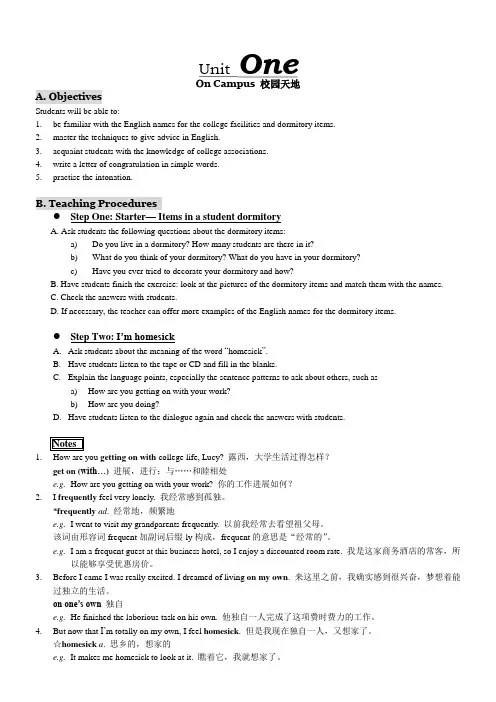
Unit OneA. ObjectivesStudents will be able to:1.be familiar with the English names for the college facilities and dormitory items.2.master the techniques to give advice in English.3.acquaint students with the knowledge of college associations.4.write a letter of congratulation in simple words.5.practise the intonation.B. Teaching Procedures●Step One: Starter— Items in a student dormitoryA. Ask students the following questions about the dormitory items:a)Do you live in a dormitory? How many students are there in it?b)What do you think of your dormitory? What do you have in your dormitory?c)Have you ever tried to decorate your dormitory and how?B. Have students finish the exercise: look at the pictures of the dormitory items and match them with the names.C. Check the answers with students.D. If necessary, the teacher can offer more examples of the English names for the dormitory items.●Step Two: I’m homesickA.Ask students about the meaning of the word “homesick”.B.Have students listen to the tape or CD and fill in the blanks.C.Explain the language points, especially the sentence patterns to ask about others, such asa)How are you getting on with your work?b)How are you doing?D.Have students listen to the dialogue again and check the answers with students.1. How are you getting on with college life, Lucy? 露西,大学生活过得怎样?get on (with…) 进展,进行;与……和睦相处e.g. How are you getting on with your work? 你的工作进展如何?2. I frequently feel very lonely. 我经常感到孤独。

新编实用英语综合教程1教案Lesson Plan for New Practical English Comprehensive Course 1。
Objective:Introduce students to the basic principles of English pronunciation and grammar.Develop students' reading, writing, speaking, and listening skills.Increase students' vocabulary and cultural awareness.Materials:Textbook: New Practical English Comprehensive Course 1。
Whiteboard or chart paper.Markers.Audio-visual aids (optional)。
Procedure:1. Warm-up (5 minutes)。
Greet students and lead them in a few simple icebreakers to get them talking in English.Examples:Good morning/afternoon, class.How are you today?What is your name?2. Introduction (10 minutes)。
Explain the objective of the lesson and the importanceof learning English.Provide a brief overview of the topics covered in the textbook.Ask students to share their prior knowledge of English or any experiences they have had with the language.3. Lesson Development (45 minutes)。
《新编实用英语》(综合教程)UnitOneSection ⅠLesson PlanContent: Section ⅠTalking face to faceAim: The topic area of Taking Face to Face in this unit is to talk about greeting people and introducing with each other. The focus of functions is to Let Students get to know how to introduce and give personal informationImportant and difficult points:Procedure and methods:Step I. Leading-in1. Pre-class Work: Giving questions about the topic related to greeting and introduction2. Warming up for the new class3. Student Activity:1).Answering the questions presented by the teacher2). Making self-introductionStep II. Dialogue learning1. Explanation of the dialogue2. Giving sample dialogues based on the business card and passport3. Student Activity:1). Listening to the tape recording of the dialogues2).Pair work: Learning the dialogues by heart and Reading out the dialogues loudly in pairs.Step ⅢActing outAfter learning the five dialogues on the book1 Dividing the students into groups of four or five2 Offering more situations for students to make dialogue3 Summarizing this part4 Student Activities:1).Group discussion: Following the dialogue and making dialogues based on the given situations2). Comments on classmates’performanceStepⅣPutting in use1. Completing and checkingInstructions: Ask students to work in groups to complete by filling in the blanks on Page 4, and then check the answers in class.2. RespondingInstructions: Ask students to practice Exercise 2 on Page 4 of the textbook orally . Offer the situation in Chinese, and ask students to give the English version, the whole class works together. After each activity, check the answers and make comments promptly.Section ⅡLesson planSection ⅡListening Practice (for 90 minutes)Objectives/Learning Outcomes: Correct understanding of the listening material about greeting and introducing peopleTime Topic Teaching Method Student Activity AssessmentmethodAids20 minutesStep ⅠListeningand decodeListen andrespond1) Introduction of listeningcomprehension2) Explanation of the dialogueand comments1) Choosing the rightwords they hear2) Answering thequestions based onthe dialogue theyhear1) Questioning thestudents withsome words andphrases relatedwith the listeningmaterial2) Distinguishingsound -similarwords3) SimulatedperformanceTaperecording ofthedialogues15 minutes Step II.Listen andcompleteListen andjudge1) Introduction of somelistening skills: How to catchthe information you need2) Checking the answers1) Listening to thedialogue2) choosing the rightanswer for themultiple choiceexercises40 minutes Step ⅢListen andreadListen andmatch1).Explanation of the keywords2).Explanation of the listeningmaterial3).Checking the answers1) Filling in theblanks with thewords they hear2) Matching theinformation incolumn A withchoices in column B3) Writing out thegeneral idea of thepassage byContent: Section ⅡBeing All EarsAim: Make the students master more useful vocabulary phrases and sentences to express themselves in English .when they meet people and introduce with each other. Important and difficult points:1. Introduction:Listening comprehension is the receptive skill in the oral mode. When we speak of listening what we really mean is listening and understanding what we hear.In our first language, we have all the skills and background knowledge we need to understand what we hear, so we probably aren't even aware of how complex a process it is. Here we will briefly describe some of what is involved in learningto understand what we hear in a second language.2.Listening Situations:There are two kinds of listening situations in which we find ourselves:·Interactive·non-interactive.Interactive listening situations include face-to-face conversations and telephone calls, in which we are alternately listening and speaking, and in which we have a chance to ask for clarification, repetition, or slower speech from our conversation partner. Some non-interactive listening situations are listening to the radio, TV, films, lectures, orsermons. In such situations we usually don't have the opportunity to ask for clarification, slower speech or repetition.Listen for main ideas. The main ideas are the most important points the speaker wants to get across. They may be mentioned at the start or end of a talk, and repeated a number of times. Pay special attention to statements that begin with phrases such as "My point is..." or "The thing to remember is..."Give your full attention on the person who is speaking. Don't look out the window or at what else is going on in the room.Remember: time is on your side! Thoughts move about four times as fast as speech. With practice, while you are Listening you will also be able to think about what you are hearing, really understand it.Procedure and methods:Step ⅠListen and decode & Listen and respond1. Introduction of some listening skillsInstructions: Help students get to know how to distinguish sound-similar words.2. Explanation of the dialogue and commentsInstructions: In this part students must choose out the words they hear from the tape recording. After playing the tape twice, check their answers.3. RespondingInstructions: After listening to the tape for the third time, students are asked to answer the questions listed out in the textbook orally.Step II. Listen and complete & Listen and judge1. Completing after listeningInstructions: Ask students to fill in the blanks with the words they get from the tape recording after hearing it for twice.2. Judging after listeningInstructions: After students listen to the same dialogue for the third time, ask them to choose the correct answers to the given sentence.Step Ⅲ.Listen and read, Listen and match1. Explanation of the key wordsInstructions: Students are going to hear a passage with some blanks for them to fill in. Before playing the tape recording, explain some key words which will appear in it. Ask students to memorize these words.2. Explanation of the listening materialInstructions: After students finish the filling-in, explain some difficult language points in the passage.3. Matching after listeningInstructions: In this part a dialogue will be given to each of the students, after they listen to it, they are asked to match the information in Column A with the choices in Column B. Then check their answers.4. Answering questions after listening to the passage again.Instructions: In this part the students are asked to write out the general idea of the passage in one paragraph by answering some listed questions in the textbook.Step Ⅳ. Listen and conclude1. Exercises in the workbookInstructions: Give explanations to some new words in the workbook, and ask students to finish the exercises in it, then check their answers.Asking students to memorize the new words which appear in the textbookSection ⅢLesson PlanTime Topic TeachingMethodStudent ActivityAssessmentmethodAids5minutes Step ⅠLeading-in1) Revision2) Thebackgroundinformationabout thepassage3) Warming upfor the newpassages1) Reciting somesentences theyhave learned inthe previous class2).Makingself-introduction1) Oralquestioning2) Extractedexamples3)Simulatedperformance1) Mapsof theweatherforecast2)WordsCollectionaboutweather3)Taperecordingof thedialogues35 minutes Step IIComprehensionof the passage1) Textpresentation andlanguage points2) Asking somequestions aboutthe passage3) Summarizingthe passage1) Listening tothe tape recordingof the passage2) Answering thequestions3) Retelling thepassage in a fewword20 minutes Step ⅢFurther exercise1) Conductingstudents to finishthe exercises onpage 102) Explanation ofthe difficult partsof the exercise3) Checking the1) .Finishing theexercise on page102).Learning theusage of somekey wordsContent: Section ⅢReading Comprehension“Maintaining a Sharp Eye”. The students will first read the two useful passages of "The way Americans Greet" and "A little About Me". The teacher will interpret the new words and structures in detail. Finally help the students do the exercises.Aim: Master the key words and structures, and learn something about the way American great This will give them an idea of how to greet foreigners especially American and how to introduce themselves.Important and difficult pointsProcedure and methods:Step I. Leading in1. Revision of the previous lesson2. Warming up for the new passages3. Student Activity:1).Reciting some sentences they have learned in the previous class2).Making self-introductionStep II Comprehension of the passage1.Explanation of the new words and language points in the passageA. Important Words and PhrasesInstructions: Give some examples to explain the difficult words. Ask students to make sentences with the words they just learn.1). greet: v. say words of welcome to, express one‘s feelings on receiving sb. 问候,致意,打招呼e.g.: It is important for the students to learn how to greet people in English.The American professor greets his students with “Morning!”2).relationship:n. particular connection or relation; instance of being related 关系,联系e.g.: He is making efforts to develop a lasting relationship with Lizzy.3).wave: v. move one‘s hand to and fro, up and down (to give a greeting or say goodbye) 挥手致意,舞动e.g.: Jean waved goodbye to her Chinese friends,4). leave: v. go away from; fail or neglect to take/bring sth. 离开,出发;留下,遗忘e.g.: The beautiful city has left a deep impression upon our mind.5).impression: n. effect produced on the mind or feelings 印象e.g.: His speech made a strong impression upon the audience. 他的演说给听众留下了深刻的印象。